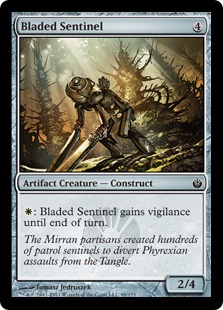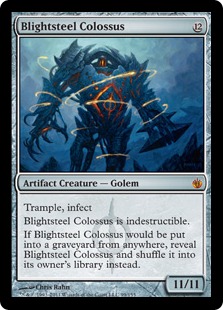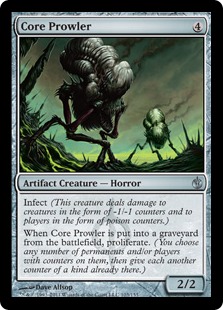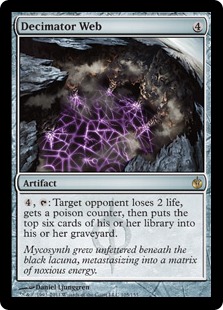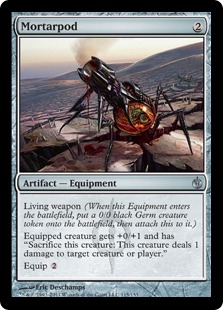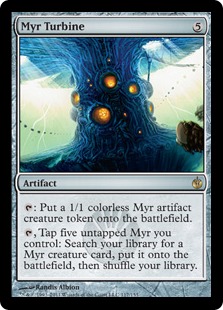Welcome to Part 2 of my Mirrodin Besieged set review. Part 1 can be found here. Today,
we’re going to jump straight into the first half of the artifacts of the set. As always, our focus will be on potential applications, rather than some
sort of 1-5 star system.
Artifacts: Part 1
Nowhere near a good enough rate for a card that offers no functional, unique element. I like the descriptor “Bladed,” however.
Blightsteel Colossus. The most controversial card in the set. Instant death.
There seems to be a lot of different reasons that people have such strong feelings about this card, none of which are linked to power level, as no one
is denying that this card is extremely powerful. Those that argue in favor of the card say that it demonstrates the corruption of Mirrodin’s greatest
weapon, helping sell just how scary the Phyrexian corruption is. They argue that Blightsteel Colossus was supposed to be unbelievably scary, and the
prospect of killing someone in a single hit is going to unnerve some people. They argue that this is a pretty epic fatty, and aliens like Emrakul make
the bar pretty high for a giant fatty to be impressive, yet Blightteel still is.
Aside on Flavor, Design, and Poison
I don’t know about you, but this block’s flavor resonates with me particularly strongly. I don’t mean Blightsteel Colossus, as Glissa and Karn sell me
on the corruption (two iconic characters that have personality) more than Inkmoth Nexus or Blightteel (two robots that just work for the other team).
What I mean is that the clash between Mirran and Phyrexian forces has a feeling of permanence that feels a bit different from regular Magical storyline
conflicts.
When Vhati il-Dal was thrown from the Predator Flagship, to his death, by Commander Greven il-Vec, it didn’t actually hit me particularly hard. He’s
just some dude, and we’re very powerful planeswalkers. If we want him alive again, we just Raise him from the Dead. In fact, Time Spiral rolled around,
and he was just wandering around due to time travel. Death isn’t the most permanent state of being in the Multiverse.
Then, consider getting hit by a Vampire Lacerator. Now a Koth of the Hammer-enhanced Mountain. Now a god-like being like Progenitus, himself. Now
picture activating Martyr of Sands. Not even Emrakul can ever hold a candle to Nomads en-Kor, Daru Spiritualist, and Worthy Cause.
Taking damage in Magic is not scary. Not only is most life gain bad and cards like Necropotence and Sign in Blood great, but the rate at which cards
let us gain life is (by necessity) generally much higher than the rate at which cards let us deal direct damage. Life points are just a resource to be
used and don’t evoke much of a physical reaction. How can we care much about life points? I mean, obviously you don’t want to lose the last one, but
none of the others really matter much. It’s nice to have that thirtieth life point for Serra Ascendant, sure, but that isn’t the same magnitude. It’s
hard to care about the thirteenth life point you lose, other than for strategic purposes when there’s always more life where that came from. Evan Erwin
once asked me what’s the most life I’d be willing to pay to draw three cards for one mana. My answer? There’s no amount of life I wouldn’t pay, if the
context was right (i.e. life gain that was astronomically good).
Poison, on the other hand, feels very permanent. It isn’t just that the tenth counter kills you, rather than the twentieth. Not being able to remove
them (other than with the Eternal powerhouse, Leeches, which is easy to not think about regularly) gives each and every counter a feeling of
significance. Yes, the first nine don’t really matter because it’s just another resource in terms of hits we can take before we lose, but no amount of
Baneslayer Angels, Martyrs of Sands, Umezawa’s Jittes, or Obstinate Baloths can undo the corruption. Â
Combining both flavor and gameplay, the execution of infect in this block is one that has impressed me most from R&D. It’s so interesting to see
the creatures only deal half damage to other creatures but have the damage be permanent. In addition, they sort of double strike but can’t combine with
non-poison well. That makes for some pretty deep game decisions for a mechanic that ostensibly sets up turn 4 kills. It isn’t just the gameplay,
however; thinking more about the mood or the “vibe” of poison, I take the permanence a step further.
When I picture infect creatures damaging planeswalkers, I don’t picture them getting sick or developing flu-like symptoms. I picture a corrupting oil
attempting to take over their very will. When random monsters get hit by infect creatures, they just get very sick then die. Sure, but planeswalkers
are very powerful beings. When I picture a planeswalker getting hit, he tries to just shrug off the influence his body has over his mind, his will.
When he receives that tenth poison counter, the corruption is complete. That tenth poison counter doesn’t just mean he loses a casual dual, it means he
too has succumbed to the corrupting influence of the Phyrexian Oil.
Of course, it probably isn’t anything like this in the storyline, and I’m reading too much into it. After all, planeswalkers are probably above all
that, and at the end of the day, you don’t have to quit Magic or be Rosewater’s slave when you get poisoned out. I’m just saying that seeing all these
characters become corrupted by the Oil and not being able to remove poison counters do add up to a cumulative effect. This Prerelease, I was planning
on playing with the Phyrexian faction, on account of their pool looking a little better. However, the morning of, I’m having second thoughts. Not
because I have a different perspective on the card quality. Rather, I just want to fight the good fight, even if the odds are against us.
What the heck is wrong with me? It’s a Prerelease, but since when did Vorthos get any of Spike’s votes? I suppose that’s a testament to just how strong
the flavor in this block is, and if the storytellers that brought us this world felt that Blightsteel Colossus was a necessary component to tell the
story this powerfully, I’m going to have to give them the benefit of the doubt. It’s still one of my five least favorite cards of all time — not
killing in one hit really mattered to me (Phage’s drawback is prohibitive); it throws away so much design space (in my opinion); costing twelve is an
insult; I would’ve stomached it a lot better if it didn’t have trample; it doesn’t feel like a creature (more like a Door to Nothingness); I don’t feel
that a corrupted robot means much of anything compared to corrupted Glissa and Karn; it’s annoying that being infected is just an advantage (rather
than having some drawback, in much the same way that many Vampire movies portray being a Vampire as just better than being a person in every way); I
don’t like the card’s impact anywhere people can cheat it (like Tinker, obviously), and to me, the card doesn’t feel like Magic. There is no drama.
Yes, Emrakul is more over the top, but he’s a brilliant design that feels like the most powerful creature ever printed. Blightsteel Colossus just feels
like the Dark Depths + Vampire Hexmage combo (Dark Depths is another of my bottom five).
If you were to imagine what kind of card a five-year-old would design, what would it look like?
“20/20, trample, indestructible.”
Silly, right?
To me, Blightsteel Colossus is just a 21/21, trample, indestructible. Wizards R&D has done such an incredible job over the past few years,
design-wise, and has certainly captured my imagination with the story of this block, so I’ll try to give them the benefit of the doubt that this card
actually was right to print, but it doesn’t mean it doesn’t hurt me to see it. Just for the record, I don’t buy into the logic that “This card isn’t
for everyone, and it was good to print because some people love it, even if other people hate it.” Really? You could’ve given it haste, and when it
enters the battlefield, make it draw seven cards, and a roughly equal number of people would’ve liked it. That doesn’t mean it was good for the game to
print. I bet an awful lot of people would love if you printed straight-up Winter Orb or a zero-cost Mox Crystal that taps for a colorless.
Seriously, who cares if some people hate it, right? By the way, I say 21/21, not 22/22, because it takes just two toughness to live, not three.
End aside
Power-wise, Blightsteel Colossus (BSC) isn’t nearly as interesting to discuss as the principle of him is. He’s entirely exactly what he looks like.
There’s subtly to him, no tricks, no cleverness, no layers. He’s used for the exact same purposes as Darksteel Colossus (DSC); he just has double
strike, meaning he kills in one hit instead of two. He’s not to be cast fair (paling in comparison to even Ulamog) but was designed to be cheated into
play with Tinker, Kuldotha Forgemaster, Shape Anew, Sneak Attack, Show and Tell, Hypergenesis, Summoning Trap, Mass Polymorph, Polymorph, or anything
else. Then when you cheat him into play, you kill your opponent in one hit, unless they have a blocker with at least a two-toughness, in which case you
kill them in two. All the same answers that can work on DSC work on BSC; you just usually have one turn to produce one, rather than two.
Verdict: Multi-format tournament staple, obviously extremely powerful brute force but not as “powerful” as Emrakul, though easier to cheat. Will see
lots of play until the next time they do this but probably won’t break many formats that aren’t already broken.
Bonehoard is one of my favorites and is currently very underrated. This is the best living weapon, assuring it a home in Stoneforge Mystic decks, at
least as a one-of. The ability to Stoneforge for a creature is a pretty amazing element, especially when the creature is a Lhurgoyf that gives you a
super-awesome equipment when it dies (or at your leisure). You may not be able to hit very hard with it early, since it needs some creatures to die
first, but four mana for a Lhurgoyf is not a bad rate, and this is basically a cantrip, as you then get the equipment. Rather, it’s almost like you get
the equipment, and the Germ token is like a cantrip (close to zero-mana in value but two mana saved from having to equip something).
Stoneforge also lets you summon Bonehoard at instant speed, uncounterably, and at a savings of another mana. This makes the Stoneforger an even more
formidable board presence, especially if you don’t know if your opponent has a Living Weapon in their hand. Bonehoard is powerful enough, though it’s
just fine to draw on its own. Sure, it doesn’t have as many tricks as the various Swords; however, it’s a very big dude and often “has haste” when you
just need your Squadron Hawk to attack for a million. Additionally, it’s a much-needed, non-red, non-white creature for Boros decks, helping to not
auto-lose to Phyrexian Crusader.
Outside of Boros, Bonehoard might also find a home in some sort of Hedron Crab deck or Fauna Shaman deck. The ability to fill your graveyard relatively
quickly has an obvious payoff here and is well worth considering. Additionally, this card is buffed enough; it might randomly just show up occasionally
in all sorts of random places, like some random Vampire deck or some random midrange deck. I’m not sure if we’re at that point, but eventually,
maindeck artifact removal becomes a realistic possibility in Standard.
As for Limited, I love the living weapon mechanic, as it’s basically a secret way to sneak some card advantage onto some cards!
A very cool Limited card with a unique enough ability that we can certainly consider it for Constructed. While he has a body only http://sales.starcitygames.com/cardsearch.php?singlesearch=Brass+Man
” target=”_new”>Andy Probasco could love, he does have an ability that can potentially save tons of mana. Additionally, the ability
to move equipment at instant speed has a variety of possible uses. While Brass Squire’s ability to move swords or random, smaller equipment is
worthwhile in Limited, we really need to save more mana than he actually costs to excite me.
The natural card to look to is Argentum Armor. Quest for the Holy Relic and Stoneforge Mystic offer no shortage of ways to find a single Armor. Kor
Outfitter is one possible way to save the mana but is somewhat awkward to wield given that what you want to be doing with your two-drop is getting him
onto the battlefield. Brass Squire allows someone that is all-in on the Armor plan more and potentially better ways to save the mana. For instance, one
natural curve is:
Turn 1: Any reasonable one-drop
Turn 2: Stoneforge Mystic getting Armor
Turn 3: Brass Squire
Turn 4: Stoneforge the Armor onto the battlefield, then Brass Squire it onto the one-drop
This is hardly going to break open the format, but it’s pretty good. Additionally, one can build a White Weenie deck that loads up on both of these
guys, plus Kor Outfitters and Quests, as well as whatever your favorite weenies and equipment might be. Such a deck is unlikely to be tier 1 but will
generally fly under the radar and might be a good way to catch people by surprise with a fun and different beatdown deck. This would be a great home
for Bonehoard, by the way, as well as Sword of Feast and Famine.
We can get a much better rate in Constructed, whether by Trusty Machete, Darksteel Axe, or Adventuring Gear. That high of an equip cost without some
unique ability is just prohibitive. If I had to imagine a use, it would be as a Trinket Mage target in a deck that absolutely must give a creature
+2/+2 for some sort of combo that cared about the size of a creature (a deck that will almost surely never exist). Alternatively, maybe Block
Constructed metalcraft White Weenie decks might be desperate for another equipment that they can get on the table fast to turn on the craft.
A fun infect creature, particularly in Limited where it lets you do some really clever things. Unfortunately, the competition is just way too tough at
the four-spot to be very interested in Core Prowling in Constructed unless proliferating is just worth that much to you in your infect deck. Such a
deck might involve Everflowing Chalice, Throne of Geth, Tezzeret, Agent of Bolas, Plague Myr, Tumble Magnet, or Inkmoth Nexus. It’s kind of interesting
how well Core Prowler works with Culling Dais, but it would take some pretty amazing additional synergy to be worth going to this trouble when we could
be Jace-ing or Titan-ing. If such a deck exists, its most likely home is Block Constructed.
A flashy card that captivates the attention but is unlikely to do much besides creating comical Limited stories. The default thing to do with a card
like this is put it onto a creature that, if your opponent can’t remove it, prevents them from winning. Platinum Angel, Platinum Emperion, Peacekeeper,
Ali from Cairo, and the like are the most obvious choices. This type of business rarely works out but probably should at least be considered if you
have some sort of a Reanimator or Tinker-esque deck capable of producing an early Platinum anything. This is, of course, of no use against Journey to
Nowhere, Black Sun’s Zenith, Into the Roil, Gatekeeper of Malakir, Consuming Vapors, Oust, Jace the Mind Sculptor, and more.
Verdict: Technically, I guess I have to go with outside chance of fringe, but I wouldn’t bet on it.
Definition of “Decimate” – transitive verb – 1: to select by lot and kill every tenth person of, 2: to exact a tax of 10 percent from
Definition of “Web” – Another term for aSwiss army knife
.
So what we have here is a Swiss army knife that kills or taxes by ten percent, which makes this among the most aptly named cards in the set. Obviously
the joke to this “versatile” tool is that each shot hits for ten percent of a player’s life total, ten percent of their starting ability to absorb
poison, and ten percent of their starting library. The milling portion of this card varies a bit more than the other two, as it mills
disproportionately fast in Limited, not to mention the fact that your starting hand and draw per turn take a toll, making setting up the trifecta
(triple-kill) a little trickier but still doable.
A fun card that will no doubt see tons of casual play, this is a pretty expensive way to do any of these things, and you’re obviously cursed by having
to pay for a lot of stuff you don’t want. Basically, the way to make this card worth it for real, not just for fun, is to be willing to pay 4 + 4 for
any one of the abilities. The most likely candidate ability is the milling one, as I could imagine someone actually wanting such a tool, but even then,
you have to compete with Keening Stone.
Verdict: Let’s keep it casual.
Ahh! Another Hound! Is the world ready for “Hound Lackey” or “Survival of the Hounds?” Without this potentially “fantastic” creature type, we’re left
with a body that’s nowhere near a good enough rate.
This is a very unassuming equipment, but I actually quite like it. You could do a lot worse than a 1/1 for a single colorless when considering that
even when it dies, you get something to show for it. This seems a fine addition to a metalcraft White Weenie deck, especially if it somehow
incorporates some equipment-based theme, such as monguises (Californian for “durdles”) that get buffed the more gear you throw on them.
Additionally, this is another cheap, very playable artifact for some sort of Kuldotha Rebirth deck. Kuldotha Rebirth has to be one of the biggest
gainers in this set, as you once had to stretch to find enough playables to pull it off but now have no shortage of great options. Additionally, living
weapon has interesting synergy with cards like Glint Hawk and Kor Skyfisher. You can deploy your Flayer Husk, throw some other gear on the Germ, then
when it dies, run the savage rebuys with either of these “gating” (bounces your own stuff) white fliers. This synergy is so nice that I fully expect
many Glint Hawk decks to run this as a four-of.
Admittedly not the worst rate but sadly not enough power to warrant a serious consideration and nothing really special going for it in the unique
department. Insect? I guess that’s an interesting creature type. An activated ability that gains flying? I guess one could imagine a possible combo
existing with this ability with Necrotic Ooze or some strange enchantment that cares when a creature gains flying. Save it for the draft.
It would take a Black Lotus discount to make this guy playable in any format, and that’s only because then you could combine it with Mishra’s Workshop
to get another Black Lotus discount. Other than that, he’s a Golem and a vanilla creature, so if you find some way to severely abuse those, go to town!
Now this is what the doctor ordered! A very cool little card that was made to be sacrificed; I can’t even imagine how many tier two decks are
celebrating the printing of Ichor Wellspring. Whereas Spellbombs merely work “well” with sacrifice effects, this card becomes downright awesome with
anything along the lines of Kuldotha Rebirth, Throne of Geth, and Arcbound Ravager. It’s not just that you’re getting a two-mana draw two; you’re also
getting a free sacrifice, which is often worth between a half and a full card. The fact that you always at least get the first card upfront, even if
you aren’t ready to do any tricks, is what seals the deal for me. It will take some clever deckbuilding to find the best ways to take advantage of this
card, but I expect that several will be found.
Verdict: A quality role-player that has chances of taking tier two strategies and elevating them a notch, if the right mix of cards can be found.
Wow, talk about a wacky card! While a symmetrical effect with no impact on the board, a high cost, and little obvious upside isn’t likely to be good,
it’s unique cards like this we must be especially diligent in judging. After all, Hive Mind was a six-cost enchantment with a symmetrical effect that
had no impact on the board! Let’s set aside the obvious casual applications of this card, which is certainly going to appeal to the Confusion in the
Ranks and Eye of the Storm crowd.
The first element of Knowledge Pool is the disruptive nature of the card. Now, whenever a player plays a spell, they don’t get that spell; they must
choose another. This is especially important when it comes to protecting Knowledge Pool. Imagine a board where some sort of Ethersworn Canonist-type
effect is on the table. Now your opponent can only cast a single spell a turn, and that spell isn’t even the spell they tried to cast. Now, if you can
cast a spell on your turn and use the spell they wanted to (like a Naturalize, for instance), they never get to use it. Remember, Knowledge Pool uses
the stack, so if you try to cast a spell on your turn, they can respond by casting an instant that will get exiled and lets them cast the card you were
trying to get off the Knowledge Pool! If you can keep all the exiled cards “bad,” then your opponent will have a lot of trouble actually casting
anything of value, whereas the last spell they play each turn will end up exiled, available for you to use against them.
The other side of the coin is to use Knowledge Pool as a super ritual. If you can arrange for the top card of your (or your opponent’s!) library to be
a bomb like Emrakul, the Aeons Torn, you can play it without paying its cost, often in the same turn you played Knowledge Pool. Now we’re starting to
formulate a picture of how to turn Knowledge Pool into a very unfair locking mechanism. What if you can consistently keep all of the removed spells
“weak cards,” or cards that don’t affect the board? For instance, if you play a Knowledge Pool on turn 4 or 5 (hopefully a little acceleration was
involved), you can then immediately drop a Chalice for zero and cast a spell that was exiled. For sure, the first step is doing a StarCityGames.com spoiler generator search for cards that reference “top of your
library.”
Putting amazing cards on top of your library then casting zero-cost spells is obviously pretty insane, but even if you get stuck without knowing the
top of your library, you can use those zero-drops (or other cheap spells) to get a bunch of free spells and shut off your opponent’s options. Imagine
you end up missing anything good, but you still have a couple zero-drops. If your opponent flipped two spells and a land, you can cast his two spells,
leaving the entire exiled pool filled with “bad cards.” You just got a Primeval Titan and a Cultivate or a Jace and a Doom Blade, but when he tries to
play a spell next turn, he has to waste the first spell, getting something worthless. To make matters worse, if he can only play one spell per turn,
he’ll be hopelessly trapped just summoning your Chalices, Mox Opals, Spheres of the Suns, Keys, or whatever.
This is going to be pretty freaking hard card to use at all, let alone break, but there’s massive potential there. You’re crazy if you think Conley
Woods won’t be thinking about this mental puzzle! This is definitely a Johnny card if I ever saw one, but so were Aluren, Earthcraft, and Donate!
Verdict: Probably not good but might be amazing if someone cracks the code.
A sweet card for Limited, to be sure, but a Black Lotus away from being fast enough for
Constructed.
Mirrorworks is definitely a unique enough effect that it’s worth taking a closer look to more fully understand. To begin with, this is a card drawer
that basically lets you copy every artifact you play. That is to say, in many ways, it’s an artifact that taps to draw a card, but that card is always
Copy Artifact or at least a two-mana version of Sculpting Steel. Is that good? Well, it’s certainly a very reasonable rate, mana-efficiency-wise. The
real question is what artifacts are entering the battlefield that you’re will to pay two generic mana to copy?
I suppose you could play a bunch of Voltaic Keys, Thrones of Geth, Lux Cannons, Spheres of the Suns, and all the other usual “Machine” suspects. This
is a pretty ambitious way to spend mana, seeing as we’re talking about adding a slow card drawer to a deck full of “do-nothings,” but it’s a deck that
wants to “draw cards,” so it’s at least worth considering.
Another possibility is to combine this card with just good artifact creatures, like Lodestone Golem, Molten-Tail Masticore, or Steel Overseer, just to
have more of a good thing. Alternatively, we could look to abuse the card with anything that lets us bounce artifacts back to our hand, especially if
it’s repeatable. Yet another use is to combine this card with artifacts that get better in multiples. Yeah, most likely, this card is a little too big, but the rate is decent if you’re in the market for a strange tome in your artifact-centric deck. Longshot at fringe, outside of maybe
Block where such a strategy might not be overwhelmingly slow. Copying Horizon Spellbomb is a good time!
I gotta keep it all the way real. A Dingus Egg for artifacts was really not at the top of my wish list. What would it take to make this card good?
Well, I suppose one possibility is if we have some efficient way to make a bunch of artifact contraptions for our opponents, and then destroy them all
at once. More realistically, I suppose this might be a special sideboard card against someone playing a deck that has to sacrifice a lot of artifacts
to do anything. It’s pretty slow for such a purpose, but I suppose there are some strategies that could be built that would not be able to beat this.
This might be the first card I have ever seen that feels sort of like an enchantment, sort of like an equipment, sort of like a sorcery, sort of like
an instant, and sort of like a creature. There are definitely a variety of unique effects going on with this card, so it’s going to require further
consideration. To begin with, you get a 0/1 for two mana that can sacrifice to deal one damage to a target. That’s actually not the worst deal, by any
means. Yes, it doesn’t beatdown quite as hard as Mogg Fanatic, and it costs more, but often, killing a Lotus Cobra or a Geopede or a Pulse Tracker for
two mana sounds great. Additionally, you don’t have to sacrifice the guy immediately, which is especially important if you play a bunch of other
equipment (which you probably do if this is in your deck). Germs make for fantastic chump-blockers to be sure.
Later, you have another piece of gear that can be moved to help buff your guys as well as provide some counter play against removal. Additionally, this
makes for a fine way to “Fireball” someone out, if it comes to that. This is particularly potent on a creature like Bloodghast, giving you a
machine-gun combo that can take over a game on its own. I have to imagine that every Vampires player worth their salt will at least try Mortarpod,
especially if they use cards like Mark of Mutiny.
That Stoneforge Mystic can retrieve Mortarpod should go without saying, but it’s important to note, as it gives Boros not only a tutorable guy (besides
Bonehoard) but also is tutorable direct damage. Alternatively, infect decks may even consider this card, as it causes the creature to deal the damage,
making for a doubly effective final Fireball plan.
While these are just some of the surface-level uses for Mortarpod, such an open-ended engine card is sure to find plenty of other applications as time
goes on. Keeping in true Mirrodin fashion, Mortarpod is hardly “busted” but offers very appealing potential synergies and ought to be kept in mind when
building combo decks.
While hardly passable on numbers (Tukatongue Thallid didn’t exactly make waves and cost a mana less), Myr Sire does have the benefit of being in a set
that would love to have good artifacts to sacrifice to toys like Throne of Geth. Additionally, Myr Sire might have utility in some sort of dedicated
Myr deck. My hunch is that a true Machine deck, with Throne of Geth and all, is going to have too many two-drops to have us interested in dropping this
guy and just hanging out, especially taking into consideration Ichor Wellspring also
being in the set. Dedicated Myr decks will likely not be shy of two-drops either, making me fairly cool on Myr Sire’s chances at much Constructed love
(though he’s fine in Limited). The only thing he has going for him besides his creature type is the ability to produce two bodies or two artifacts to
sacrifice, if you’re in the market for such a thing.
Elspeth is back! Okay, not really, since you and I both know it was actually Elspeth’s +3/+3 ability that made her so fearsome and at four mana to
boot, but Myr Turbine does have some nice bells and whistles. Obviously, it can’t be attacked like Elspeth can, and tapping to produce another token
every turn is a pretty respectable rate. The fact that they’re artifact creatures makes them exceptionally easy to gain added value from them; plus, if
there’s a Myr deck, this plays a major role.
The second ability may appear to be a bone to the casual crowd at first glance but is actually a pretty powerful dimension that gives Myr Turbine a
very ultimate-like feel. If you can amass a supply of five Myr, whether all from the Turbine, or perhaps a few by surprise with Master’s Call, or just
from random Origin Spellbomb Myr lying around, you can Tinker up a Myr Battlesphere and threaten a one-hit kill. Myr Battlesphere is a fine card as can
be seen from its generally being regarded as the best pre-Besieged Tinker target, despite only costing seven. It’s a two-turn clock, produces tons of
board presence, fights Jace well, and doesn’t even have a throat! Turn 2 Sphere of the Suns or Everflowing Chalice, turn 3 Everflowing Chalice for two,
turn 4 hard cast!
While it’s certainly ambitious, I don’t actually think it’s out of the question for a dedicated Myr deck to be able to have five Myr already available
when the Turbine hits, letting you summon the Battlesphere immediately. It’s not like you lose them, either. Even if your opponent can deal with the
Sphere, you can summon another one next turn! Myr Galvanizer is a small payoff, sure, but Myr Turbine and Myr Battlesphere — now there’s
an incentive to build a true Myr deck.
Most likely, Myr Turbine will prove too slow to just put in random decks for value, though it’s not out of the question. More likely, he’ll be prized
by players looking to exploit the card. Voltaic Key, for instance, not only lets you get paid double; you get Myr Battlesphere after waiting only two
turns instead of five. If you have a deck that seems to get a lot of Voltaic Keys on the battlefield, I’d consider Myr Turbine early in the brewing.
An interesting “backup” to whatever tricky thing you’re trying to pull off; I’m not super impressed, but at least he has a not-embarrassing body. What
are the best activated abilities? Well, obviously imprinting Time Vault is just game, so there’s that. Obviously, everything is fair game in Vintage
anyway, but this combined with Entomb is a win, and there are obviously plenty of other ways to pull this off (though that does seem a bit glacial in
the format). In addition, there are plenty of more recent cards, like Molten-Tail Masticore, Mindslaver, Kuldotha Forgemaster, Myr Galvanizer, Lux
Cannon, and Master Transmuter. Additionally, there are about a million combinations of two cards you can imprint to win the game (or at least generate
some sort of
infinite regression
), such as Khalni Gem + Soliton.
Will Myr Welder actually do any of this crazy stuff in tournament play? Probably not, but this is a unique enough card that you never discount it or
the potential to break it if the right card gets printed or the right combo gets discovered. The other obvious use is just to serve as backup for
something else. You really want to Transmuter or Forgemaster? Maybe you’d be willing to use this as an additional copy of each of those. It should also
be noted that you can hit your opponent’s yard, which is hard to take advantage of but might allow for some wild surprise maneuver.
I’ve been asked to not discuss what happens when you imprint Transmogrifying Licid and Tatsumasa, the Dragon’s Fang.
Obviously we can do a lot better if we’re white or green, probably even black, but Bottle Gnomes saw plenty of play, and Peace Strider is more
efficient. It’s nowhere near the power level of many of our favorite four-drops, these days, but I could totally see a blue deck or a red deck just
really wanting some life gain on a body. For instance, I could imagine a world where Faeries might consider this as a way to get more anti-Stag power
while also gaining percentage against Red. I imagine Nighthawk and Wurmcoil are better, but it should be considered. As a result, Peace Strider has to
be put in the playable category, just not likely to see much action.
Both black and green have plenty of superior infect creatures at this spot on the curve, so it’s highly unlikely that we’ll want his services. The main
thing he has going for him is that he’s an artifact, rather than back or green, meaning if we somehow built a non-black, non-green infect deck, he
might be a consideration (though the question of why we’d want to do that without just relying on Inkmoth Nexus or Blightsteel Colossus seems tough to
answer).
Alright, thanks for joining me today. Same place, same time tomorrow, as I continue my Mirrodin Besieged Set Review!
Patrick Chapin
“The Innovator”


